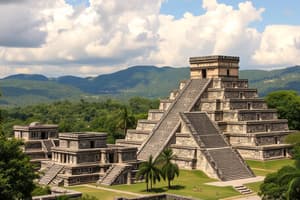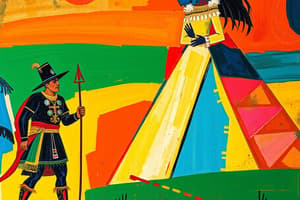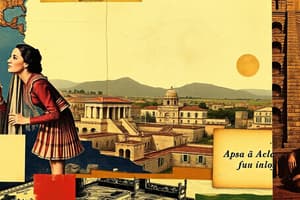Podcast
Questions and Answers
In Aztec society, what was the primary method of transmitting knowledge and traditions?
In Aztec society, what was the primary method of transmitting knowledge and traditions?
- Religious sermons and theological debates.
- Oral tradition through stories, songs, and poetry. (correct)
- Formal tutoring and written texts.
- Scientific experiments and mathematical proofs.
Which of the following statements accurately describes a key difference between Aztec and Spanish education systems?
Which of the following statements accurately describes a key difference between Aztec and Spanish education systems?
- Aztec education focused on practical skills like agriculture, while Spanish education prioritized intellectual pursuits like philosophy and literature.
- Spanish education was heavily influenced by the Roman Catholic Church, whereas religion played a less central role in Aztec education. (correct)
- Aztec education was exclusively for boys, while Spanish education included both boys and girls.
- Both systems equally emphasized religious instruction and practices for all students.
How did social class primarily impact education in Aztec society?
How did social class primarily impact education in Aztec society?
- Curriculum varied based on gender and social class, with different expectations for each group. (correct)
- Slaves (Tlacotin) received specialized education focused on serving the upper classes.
- All social classes received the same education, ensuring equality.
- Education was solely reserved for the Pipiltin (upper class), excluding other classes.
In Spanish society, which group held significant influence in religious matters and education?
In Spanish society, which group held significant influence in religious matters and education?
What was the main source of wealth accumulation for the Aztecs?
What was the main source of wealth accumulation for the Aztecs?
Which of the following technologies was utilized by the Spanish but not by the Aztecs?
Which of the following technologies was utilized by the Spanish but not by the Aztecs?
How did the Spanish primarily distribute wealth?
How did the Spanish primarily distribute wealth?
Which of the following describes a key function of trade in the Aztec economy?
Which of the following describes a key function of trade in the Aztec economy?
How did Aztec religious beliefs influence their warfare practices?
How did Aztec religious beliefs influence their warfare practices?
What was a primary source of conflict between the Aztec and Spanish cultures?
What was a primary source of conflict between the Aztec and Spanish cultures?
How did the roles of women in Aztec and Spanish societies differ?
How did the roles of women in Aztec and Spanish societies differ?
What advantage did the Spanish military have over the Aztec military?
What advantage did the Spanish military have over the Aztec military?
What role did religious leaders play in both Aztec and Spanish societies?
What role did religious leaders play in both Aztec and Spanish societies?
What was the main objective of Spanish military campaigns, beyond territorial expansion?
What was the main objective of Spanish military campaigns, beyond territorial expansion?
How did the expected roles of children differ between Aztec and Spanish societies?
How did the expected roles of children differ between Aztec and Spanish societies?
What did the Aztecs believe about the afterlife?
What did the Aztecs believe about the afterlife?
Flashcards
Aztec Knowledge Transfer
Aztec Knowledge Transfer
Knowledge was passed down through stories, songs, and poetry.
Aztec School Attendance
Aztec School Attendance
All Aztec children attended, but education differed by gender and class.
Spanish Knowledge Transfer
Spanish Knowledge Transfer
Formal tutoring and lessons were used.
Spanish Education Access & Religion
Spanish Education Access & Religion
Signup and view all the flashcards
Aztec Social Classes
Aztec Social Classes
Signup and view all the flashcards
Spanish Social Classes
Spanish Social Classes
Signup and view all the flashcards
Aztec Technology
Aztec Technology
Signup and view all the flashcards
Spanish Technology
Spanish Technology
Signup and view all the flashcards
Aztec Afterlife
Aztec Afterlife
Signup and view all the flashcards
Aztec Religious Leaders
Aztec Religious Leaders
Signup and view all the flashcards
Aztec Religious Events
Aztec Religious Events
Signup and view all the flashcards
Spanish Afterlife (Catholicism)
Spanish Afterlife (Catholicism)
Signup and view all the flashcards
Aztec Women's Roles
Aztec Women's Roles
Signup and view all the flashcards
Spanish Women's Roles
Spanish Women's Roles
Signup and view all the flashcards
Aztec Military Training
Aztec Military Training
Signup and view all the flashcards
Spanish Military Advantage
Spanish Military Advantage
Signup and view all the flashcards
Study Notes
- Study notes comparing the education systems, social structure, technology, religion, family structures, and warfare of the Aztec and Spanish civilizations.
Aztec Education
- Knowledge was passed down through oral tradition, including stories, songs, and poetry.
- Singing and dancing were key methods for passing on traditions and values.
- All boys and girls attended school with a gender and social class based curriculum.
- Boys were taught to become warriors, while girls trained in household management.
- Religion did not play a huge role in education.
Spanish Education
- Knowledge was passed down through formal tutoring and lessons.
- Both boys and girls attended school, with more limited access to education for girls.
- Religion played a crucial role, with education closely tied to the Roman Catholic Church.
Aztec Social Structure
- The class system consisted of Pipiltin (nobility/ruling class), Macehaultin (commoners/artisans/traders), Mayeques (peasants), and Tlacotin (slaves).
- Nobles ruled and had high-status roles while commoners were farmers, artisans, and traders.
- Peasants worked the land, and slaves performed hard labor.
Spanish Social Structure
- The class system consisted of nobility, clergy, and commoners.
- Nobles had land and power, clergy were influential in religious matters.
- Commoners worked for the upper classes.
Aztec Tools & Technology
- Developed advanced mathematics and a sophisticated calendar system.
- Created tools for agriculture, architecture, and warfare.
- Wealth accumulated mainly through agriculture, tribute from conquered territories, and trade.
- Trade was essential to the economy, involving items like cacao beans, textiles, and precious metals.
Spanish Tools & Technology
- Utilized advanced European technology, such as firearms, metalworking, and navigation tools.
- Had a more developed system of measuring time based on the Gregorian calendar.
- Wealth was gained through colonial exploitation, agriculture, and mining (silver).
- Wealth was often distributed among the crown, church, and nobility.
Aztec Religion
- Believed in an afterlife where the soul would travel to various destinations depending on the way the person lived and died.
- Priests and the Great Council were responsible for religious duties and the administration of rituals.
- Held grand ceremonies, including human sacrifices, to honor gods like Huitzilopochtli and Quetzalcoatl.
- Conflicts arose with external cultures (like Spain) over religious practices like human sacrifice.
Spanish Religion
- Heavily influenced by Roman Catholicism, which focused on Heaven, Hell, and Purgatory.
- The Pope and clergy held great power in determining spiritual matters.
- Religious ceremonies were central to daily life, including mass, festivals, and prayers.
- The Aztec religion conflicted with Catholic teachings, especially regarding human sacrifice and polytheism.
Aztec Family Roles
- Men were expected to become warriors, work the land, and provide for the family.
- Women were in charge of household duties and childcare.
- Higher-status women had some involvement in religious activities.
- Boys were trained to become warriors, and girls learned how to manage a household.
Spanish Family Roles
- Men were the head of the household and were responsible for work and governance.
- Women were largely confined to domestic roles, managing the household and caring for children.
- Children were expected to respect their parents and were trained for their future roles in society.
Aztec Warfare
- Notable leaders include Montezuma II and Ahuitzotl.
- Military prowess was central to Aztec culture; they trained young boys to become warriors.
- Warfare was often about capturing prisoners for sacrifice rather than territorial conquest.
- Religion played a central role, as warriors believed they were serving the gods by engaging in battle.
Spanish Warfare
- Hernán Cortés and other conquistadors led military campaigns against indigenous groups.
- Spanish military forces used advanced weaponry, including firearms and horses.
- Military campaigns were driven by the desire to expand territory and convert indigenous peoples to Christianity.
- Religion was a major motivator for conquest, with the Spanish believing they were spreading Christianity.
Studying That Suits You
Use AI to generate personalized quizzes and flashcards to suit your learning preferences.




